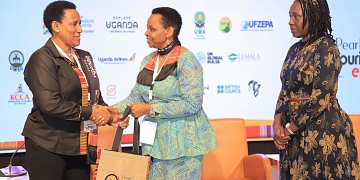
Destination Uganda continues its economic recovery beyond COVID-19 with focus on rebuilding a resilient sector through unique tourism opportunities such as Mountain tourism.

With support from the Ministry of Tourism, Wildlife & Antiquities, UNDP and Tooro Kingdom, the Uganda Tourism Board has embarked on the promotion of sustainable adventure tourism under the Campaign – Conserving Mountain Ecosystems – to highlight the beauty and splendor of the Rwenzori Mountain ranges as one of the remaining equatorial glaciers in the world.
 Part of the campaign activities include a 10-day Rwenzori Royal Expedition to the Margherita peak led by His Majesty – Omukama Oyo Nyimba Kabamba Iguru Rukidi IV to draw attention to the impact of climate change, the significant role of environmental conservation and the promotion of the Rwenzori Mountains as a unique adventure tourism attraction.
Part of the campaign activities include a 10-day Rwenzori Royal Expedition to the Margherita peak led by His Majesty – Omukama Oyo Nyimba Kabamba Iguru Rukidi IV to draw attention to the impact of climate change, the significant role of environmental conservation and the promotion of the Rwenzori Mountains as a unique adventure tourism attraction.
 One of the most visible consequences of climate change in Uganda is the rapid loss of glaciers, which have reduced from 6.5 square kilometers in 1906 to less than one square kilometer in 2003. These Rwenzori glaciers will disappear before the end of this century.
One of the most visible consequences of climate change in Uganda is the rapid loss of glaciers, which have reduced from 6.5 square kilometers in 1906 to less than one square kilometer in 2003. These Rwenzori glaciers will disappear before the end of this century.
 The local communities living at the foothills of the Rwenzori Mountain continue to face destructive floods, as a result of the outbursts of River Nyamwamba whose source is traced in these mountains. Nonetheless, the mountains remain an important part of the Batooro, Bakonzo and Bamba Culture.
The local communities living at the foothills of the Rwenzori Mountain continue to face destructive floods, as a result of the outbursts of River Nyamwamba whose source is traced in these mountains. Nonetheless, the mountains remain an important part of the Batooro, Bakonzo and Bamba Culture.

“There is an urgent need to preserve the crown of snow on the Rwenzori Mountains. Therefore, we must be prepared to tackle the effects of climate change on our beautiful country today.” – Owekitinisa Joan Kantu Else, Minister of Tourism – Tooro Kingdom.

The Rwenzori Ecosystem is also a great contributor to tourism development. It is home to 54 Albertine rift endemic species; 18 mammal species, 09 reptile species, 06 amphibian and 21 bird species. Over 217 Bird species including the Rwenzori Turaco, the Bamboo Warbler, Golden Winged Sun bird, Scarlet tufted Malachite sun bird, have been recorded rendering the ecosystem as an important bird watching site in Uganda.
 In 1994, the Rwenzori Mountains were named as a UNESCO World heritage site and later as a Ramsar Site in 2008 due to the unique beauty and vegetation zones marked by grassland, montane forest, Bamboo, heather and afro-alpine moorland zones which support diverse species of bird and other wildlife.
In 1994, the Rwenzori Mountains were named as a UNESCO World heritage site and later as a Ramsar Site in 2008 due to the unique beauty and vegetation zones marked by grassland, montane forest, Bamboo, heather and afro-alpine moorland zones which support diverse species of bird and other wildlife.
“The Rwenzori Royal Expedition 2022 will not only create awareness on the restoration and protection of areas affected by climate change, but also to drum up support for culture and heritage tourism promotion in our beautiful country” – Hon Daudi Migereko, Chairman Board of Directors, Uganda Tourism Board.

Therefore, the expedition has highlighted the untapped tourism product development opportunities available in the Rwenzori region that will offer an adventure of a lifetime to travellers from all over the world while in Uganda – The Pearl of Africa.
Mountain tourism, complimented by wildlife Safaris, primate tracking, bird watching in the Queen Elizabeth, Kibale and Bwindi Impenetrable National Parks, accented by culture and heritage of the local communities.

“The Ministry of Tourism, Wildlife& Antiquities will continue to support the private sector to develope bespoke tourism products in order to enhance traveller experiences throughout the country.” – Hon. Tom Butime, Minister – Ministry of Tourism, Wildlife & Antiquities.
“Uganda Tourism Board (UTB) is a statutory organisation established in 1994.
UTB is mandated to promote and market Uganda domestically, across the region and internationally, promote quality assurance in tourist facilities through training, grading and classification, promote tourism investment, support and act as liaison for the private sector in tourism development.




















